Bega Valley
Indicator: Land Degradation
Results for this indicator are also available for [an error occurred while processing this directive]
What the results tell us for Bega Valley
For the 2004-08 reporting period, high salinity risks were identified in one localised area, and landuse in the Shire remained largely compatible with its capability class. Drought was experienced throughout the Shire for much of the period. Since the last reporting period there has not been any noteworthy data or information released on erosion, acidic or sulphate soils.
Sustainability of landuse
See also: Landuse
Landuse within the Bega Valley Shire tended to be suitable land capability class (refer Figure 1 and Table 1). Approximately 2% of land in use is vulnerable to erosion because of unsuitable practices.
Figure 1. Land use within the Bega Valley Shire
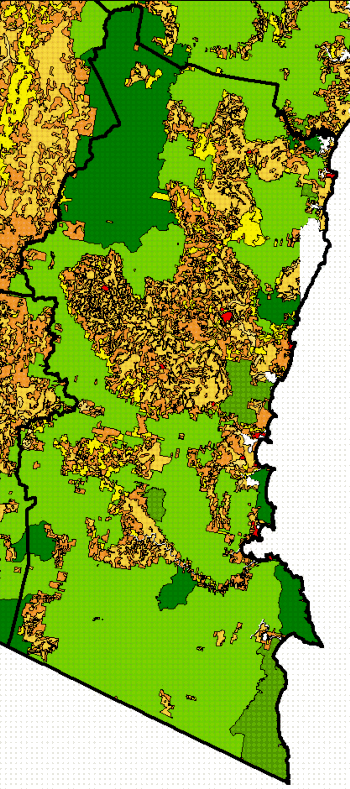

| Landuse | Land Capability Class | |||||||
|---|---|---|---|---|---|---|---|---|
| Lands suitable for regular cultivation | Lands suitable for grazing—occasional cultivation | Lands suitable for grazing—no cultivation | Other lands | |||||
| I | II | III | IV | V | VI | VII | VIII | |
| Cropping | 266 | 524 | 3,598 | 261 | 1,343 | 82 | 172 | |
| Estimated grazing | 173 | 1,426 | 240 | 56,187 | 5,573 | 29,616 | 3,314 | 1,676 |
| Mixed farming | 114 | 312 | 6,132 | 535 | 2,267 | 189 | 78 | |
| Other plantations | 78 | 106 | 318 | 353 | 18 | |||
| Rural residential | 0 | 23 | 1,032 | 19 | 670 | 6 | 27 | |
| Totals (hectares) | 554 | 2,362 | 346 | 67,266 | 6,388 | 34,248 | 3,590 | 1,972 |
Some 16% of land within the Shire is classed as suitable for grazing of which 95% of this land is used for grazing. The remaining 5% of land is considered at high risk of erosion if cleared and according to the Department of Lands it is recommended that it remains vegetated or is revegetated.
Some 1% of the Shire is under cultivation of which 85% of this land was not suitable for reasons of either climatic conditions or soil degradation (CSIRO 2003).
Types of land degradation
Erosion
Soil erosion data was restricted to surveys carried out between 1985 and 1992 (refer Figure 2 and Tables 2 and 3). The surveys revealed 19 km of gully erosion and 96 km of stream bank erosion (refer Table 2). Minor to severe sheet erosion was present throughout the Shire (refer Table 3).
Gully erosion was predominately classed as sever to extreme with gullies less than 3.0m deep (Table 2), most of which was caused soon after the original native vegetation was removed. Gully lengths have since stabilised however accelerated erosion continues as is revealed by the high sediment loads to streams relative to (Hughes and Prosser 2003). In New South Wales (NSW) the estimated overall accelerated erosion rate are 10–50 times the natural rates (Edwards and Zierholz 2001).
Figure 2. Degree of erosion
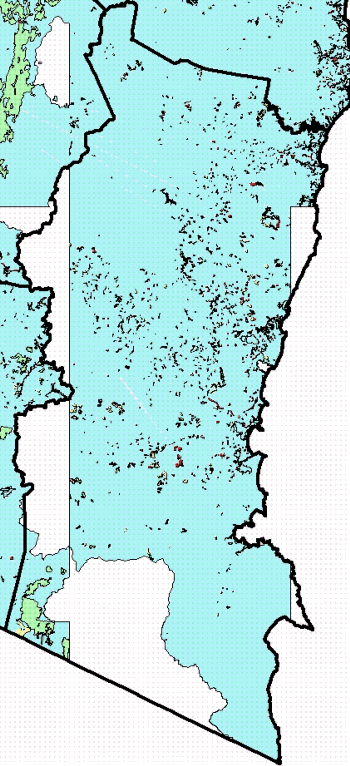
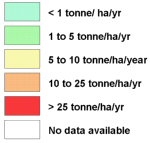
Source: Department of Lands 2008
| Erosion type | Depth | Kilometres |
|---|---|---|
| Extreme gully erosion | greater than 6m deep | 0.4 |
| 3 to 6m deep | 2 | |
| 1.5 to 3m deep | 4 | |
| less than 1.5m deep | 3 | |
| Extreme gully erosion total | 9 | |
| Severe gully erosion | 1.5 to 3m deep | 0.6 |
| less than 1.5m deep | 0.9 | |
| Severe gully erosion total | 1.5 | |
| Moderate gully erosion | greater than 6m deep | 0.2 |
| 3 to 6m deep | 0.07 | |
| 1.5 to 3m deep | 1 | |
| less than 1.5m deep | 2 | |
| Moderate gully erosion total | 3 | |
| Minor gully erosion | 3 to 6m deep | 0.1 |
| 1.5 to 3m deep | 0.4 | |
| less than 1.5m deep | 5 | |
| Minor gully erosion total | 5 | |
| Streambank erosion | greater than 6m deep | 2 |
| 3 to 6m deep | 7 | |
| 1.5 to 3m deep | 52 | |
| less than 1.5m deep | 35 | |
| Streambank erosion total | 96 |
| Major erosion type | Degree / type | Hectares |
|---|---|---|
| Mass movement | rock debris avalanche | 6 |
| Slide | 20 | |
| Slump | 3 | |
| soil debris avalanche | 11 | |
| Rill erosion | extreme rill erosion | 28 |
| severe rill erosion | 40 | |
| moderate rill erosion | 67 | |
| minor rill erosion | 182 | |
| Sheet erosion | extreme sheet erosion | 940 |
| severe sheet erosion | 988 | |
| moderate sheet erosion | 2,215 | |
| minor sheet erosion | 6,798 | |
| Wind Erosion | extreme wind erosion | 21 |
| moderate wind erosion | 1 | |
| minor wind erosion | 14 |
Some erosion may have occurred within the Shire during the current reporting period due to the drought. Localised areas of vegetation will have died in the drought, though the erosive impacts are not able to be reported owing to lack of data (Madigan, 2006) (BVSC - State of Environment Report 2006/2007 - A Supplementary Report).
Salinity
During the reporting period soil salinity in the Bega Valley Shire was restricted to a small area (~4km2) north-east of Kalaru. Forecast to the year 2050 show no increase in salinity affected area (refer to Figure3 and 4).
Figure 3. Extent of salinity (2000)
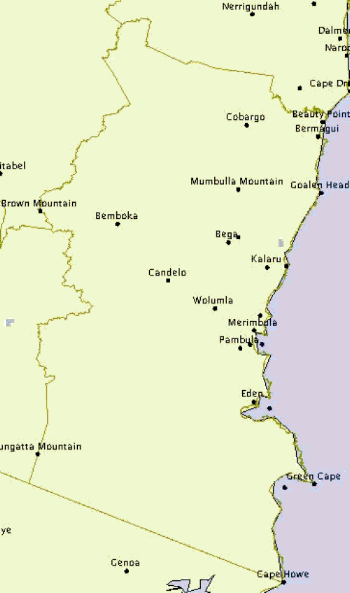
Source: Australian National Resource Atlas
Figure 4. Forecast extent of salinity (2050)
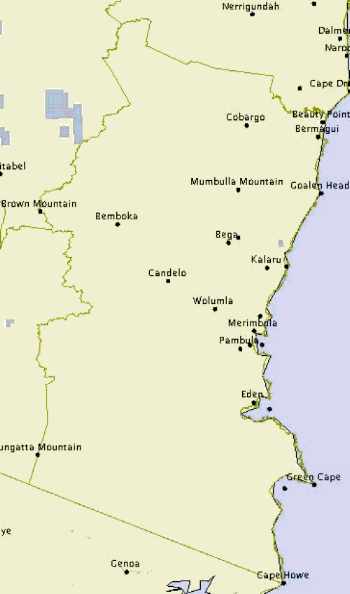
Source: Australian National Resource Atlas
Acid Soil
Soil acidity can have an impact through affects on reducing crop yields, perennial pastures, ground water quality and inturn increase soil erosion and salinity (Upjohn et al., 2005). In rural Australia soil acidity is usually associated with to nutrient depletion or fertiliser use by agriculture.
Causes of land degradation
Land degradation can be caused directly by human activities, such as land clearing, over use of fertiliser and changing water tables. Indirect influences, can include flooding of overgrazed or over cultivated land with little ground cover and erosion by wind and water. Drought breaking rain may also cause erosion and can make up about 90% of the total soil loss in an area in a 20–30 year cycle (DPI 2005).
Drought and vegetation condition
According to a recent study by the Bureau of Meteorology (BoM) and the Commonwealth Scientific and Industrial Research Organisation (CSIRO) (BoM, CSIRO 2008) the frequency and extent of exceptionally hot years and exceptionally dry years in NSW are likely to increase in the future. The mean projections indicate that:
- by 2010-2040, exceptionally hot years are likely to affect about 60% of the region, and occur every 1.6 years on average;
- by 2010-2040, no change is likely in the frequency or areal extent of exceptionally low rainfall years;
- by 2030, exceptionally low soil moisture years are likely to affect about 7% of the region and occur about once every 14 years on average.
As of September 2008 the Department of Primary Industry has classed 71.6% of NSW as ‘In drought’. This includes the Bega Valley Shire.
Figure 5. Drought declared areas
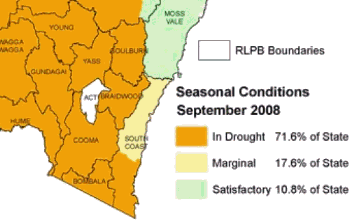
Source: Department of Primary Industries 2008
Over the reporting period the South Coast Rural Land Protection Board –Sections C & D, the area covering the Bega Valley Shire was rated as in full or marginal drought for most of the period (refer Figure 5 and Table 4) (DPI 2008). This is further illustrated in Figure 6 where the continuing drought period up to February 2007 resulted in a steady decrease in pasture growth (NAMS 2008).
| Months | Seasonal Conditions |
|---|---|
| September 2004 | Drought |
| December 2004 | Drought |
| March 2005 | Drought, marginal |
| June 2005 | Drought |
| September 2005 | Drought |
| December 2005 | Satisfactory |
| March 2006 | Drought, marginal |
| June 2006 | Drought |
| September 2006 | Drought |
| December 2006 | Drought |
| March 2007 | Drought, marginal |
| June 2007 | Satisfactory |
| September 2007 | Satisfactory |
| December 2007 | Drought, marginal |
| March 2008 | Satisfactory |
| June 2008 | Drought, marginal |
Figure 6. Pasture growth in Bega Valley Shire for the period 2004 to 2008 (Source) NAMS
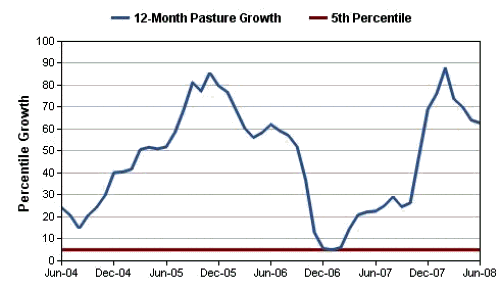
Urban development
The Shire Council's urban stormwater management plan (BVSC 2003) identifies a number of land degradation issues with respect to urban development within the Shire and outlines actions to remediate these. Issues identified in this plan include (BVSC 2003):
- erosion and sedimentation from building sites
- sedimentation and erosion from unformed road verges
- gully erosion in creeks
- chemical spills from light industrial areas
- high stormwater velocity in steep areas causing erosion
- increased stormwater velocity from developed areas with greater coverage of impervious surfaces.
Other causes
The Shire Council has also identified 43 potentially contaminated sites at the end of the current reporting period and had eight listed contaminated sites as at June 2008. Five of these were fuel/gas store sites, two of the sites were remediated during the reporting period, with another two sites still being remediated (see Contaminated Sites indicator for details)
A preliminary study of the former Bega gasworks site study by the owner has confirmed contamination. The Shire Council is waiting on a NSW Department of Environment and Climate Change (DECC) assessment of risk of harm to health or environment from contamination. Contamination has been confirmed at the ex tannery site, but remediation has not yet commenced.
The Shire Council recognises that the current listing may not be complete. The Shire Council works from the Managing Land Contamination Guidelines 1998 which determine the type of industries that can lead to potential land contamination(It should be noted that these Guidelines are currently under review by DECC). The Shire Council will continue to use these guidelines as the basis for determining whether previous land uses may have led to potential land contamination. The Shire Council also notes that DCP no. 8 "Contaminated Land Management" is set to be reviewed as part of the comprehensive LEP process. Management of contaminated land will continue as required but will be based on compliance with SEPP 55 and the Contaminated Land Management Act & planning guidelines.
What is being done to improve land condition?
Bega Valley Shire Council has in place an Annual Operational Plan setting out the objectives of multiple environmental services (BVSC: 2006 & 2007). There are several services that overlap including:
- Weed Management
- Vegetation Management
- Bushfire Hazard Management
- Estuary Management
- Environmental Management
Within these services, specific activities, outcomes and indicators have been outlined for each operational year (Refer Table 5)
| Specific activities | Key outcomes | Performance indicators |
|---|---|---|
| Management of the Tree Preservation Order as it applies to privately owned lands. | Significant vegetation managed for conservation. | TPO applications for relevant private property assessed and determined within 15 days of receipt. |
| Implementation of Vegetation Management Policy | Consistency in tree management across the Shire Community acceptance of tree management | Simplified tree management process. |
| Vegetation Recovery Project | Regional conservation targets are met Strong liaison with SRCMA and further sources for this project Develop and implement Council Works Rehabilitation Program | 75ha of private land managed for conservation outcomes under contract with Annual report to Council Regional conservation targets are met. Develop and implement Council Works Rehabilitation Program. Strong liaison with SRCMA and further investigation of alternate funding sources for this project. |
| Implementation of the Tree Preservation Order | Review the effectiveness of the existing TPO and ensure consistent assessment of applications under the TPO. Council owned trees managed in accord with the TPO and best practice through close liaison with Town Teams. | TPO applications assessed and determined within 15days of receipt. Significant vegetation managed for conservation. |
| Development of a Vegetation Management Policy | An integrated and comprehensive Tree Management Policy Consistency in tree management across the Shire. Community acceptance of tree management. | Draft policy advertised by 31 July 2006. Implementation of policy commenced by 31/12/06. Simplified tree management process to match reduced resources. |
About the data
For the current reporting period there has been a lack of new soil data due to the relatively long intervals between soil studies. Further, since the release of the 2000-2004 report, a Supplementary Report was released for the 2006-2007 year. Given the relevancy of the information in the supplementary report, some sections have been retained for this report. Where material has been used from the Supplementary Report reference has been given to the report and original source.
References
Australian National Resource Atlas Mapmaker facility http://www.anra.gov.au/mapmaker/mapservlet?app=anra
Australian Water Resources (2000) National Land and Water Audit. www.nlwra.gov.au/
Australian Water Resources (2005) Land Salinity Maps. www.nlwra.gov.au/
AWR – see Australian Water Resources
Bega Valley Shire Council (2007) Operational Plan 2006/2007 - A Supplementary Report http://www.begavalley.nsw.gov.au/Your_Council/Management_Plan/operationalplan0607.pdf
Bega Valley Shire Council (2008) Operational Plan 2007/2008 - A Supplementary Report http://www.begavalley.nsw.gov.au/Your_Council/Management_Plan/operationalplan0708.pdf
Bega Valley Shire Council (2007) State of Environment Report 2006/2007 - A Supplementary Report http://www.begavalley.nsw.gov.au/Your_Council/Annual%20Report/0607_SOE_
Supplementary_Report.pdf
BVSC—see Bega Valley Shire Council
BoM and CSIRO – see Bureau of Meteorology and the Commonwealth Scientific and Industrial Research Organisation
Bureau of Meteorology and the Commonwealth Scientific and Industrial Research Organisation (2008) An Assessment of the Impact of Climate Change on the Nature and Frequency of Exceptional Climatic Event.
Commonwealth of Australia (2005) National Action Plan for Salinity and Water Quality and Natural Heritage Trust Regional Programs Report 2003–04, Departments of the Environment and Heritage and Agriculture, Fisheries and Forestry, viewed 18 April 2005, http://www.nrm.gov.au/publications/regional-report/03-04/.
CRCCH—see Cooperative Research Centre for Catchment Hydrology
Department of Infrastructure, Planning and Natural Resources, NSW (2004a) 2003/04 Combined NSW Catchment Management Authorities Annual Report, Volume 1: CMA Activities and Achievements, Department of Infrastructure, Planning and Natural Resources, Sydney.
Department of Infrastructure, Planning and Natural Resources, NSW (2004b) NSW Coastal Salinity Audit, Centre for Natural Resources, Department of Infrastructure, Planning and Natural Resources, Parramatta, viewed 4 May 2006, http://www.dnr.nsw.gov.au/salinity/science/pdf/coastal_audit1.pdf.
Department of Infrastructure, Planning and Natural Resources, NSW (2005) Meeting the Challenge: NSW Salinity Strategy Premier's Annual Report 2003–04. NSW Department of Infrastructure, Planning and Natural Resources, viewed 12 May 2006, http://www.dlwc.nsw.gov.au/salinity/pdf/2003_2004_salinity_annual_report.pdf
Department of Land and Water Conservation (NSW) (1999) Groundwater Quality Protection Policy, Department of land and Water Conservation, Sydney, on line at http://www.dnr.nsw.gov.au/water/pdf/nsw_state_groundwater_quality_policy.pdf.
Department of Land and Water Conservation, NSW (2000) Taking on the Challenge: The NSW Salinity Strategy, Department of Infrastructure, Planning and Natural Resources, viewed 4 May 2006, http://www.dlwc.nsw.gov.au/salinity/government/govt-docs.htm.
Department of Land and Water Conservation, NSW (2002) Soil Acidification Hazard Mapping, produced for the 2003 NSW State of the Environment Report, Department of Land and Water Conservation, Parramatta.
Department of Primary Industries, NSW (2005) Soil Management Following Drought, Agnote DPI 355, Third Edition, Department of Primary Industries, viewed 18 April 2006, http://www.agric.nsw.gov.au/reader/pasture-crops-recovery/dpi355.htm.
Department of Primary Industries, NSW (2006) Drought maps—areas of NSW suffering drought conditions, Department of Primary Industries, viewed 8 May 2006, http://www.agric.nsw.gov.au/reader/drt-area?picQuant=100.
Department of Primary Industries, NSW (2008) Drought maps and drought assistance eligibility status of RLPBs http://www.dpi.nsw.gov.au/agriculture/emergency/drought/situation/drought-maps
DIPNR—see Department of Infrastructure, Planning and Natural Resources, NSW
DLWC—see Department of Land and Water Conservation, NSW
DPI—see Department of Primary Industries, NSW
Edwards, K and Zierholz, C (2001) Soil Formation and Erosion Rates, in PEV Charman and BW Murphy (eds) Soils: Their Properties and Management, 2nd Edition, pp 39–58, Oxford University Press, Oxford, cited in Lu, H, Prosser, IP, Monn, CJ, Gallant, JC, Priestley, G and Stevenson, JG (2003) Predicting sheetwash and rill erosion over the Australian continent, Australian Journal of Soil Research Vol. 41, 1037–1062, viewed 3 May 2006, http://palaeoworks.anu.edu.au/pubs/AustJSS03.pdf.
Hughes, AO and Prosser, IP (2003) Gully and Riverbank Erosion Mapping for the Murray-Darling Basin, Technical Report 3/03, March 2003, CSIRO Land and Water, Canberra, viewed 26 April 2006, http://www.clw.csiro.au/publications/technical2003/tr3-03.pdf.
National Agricultural Monitoring System (Namms) (2008), Simulated Pasture Growth for the Bega Valley, http://www.nams.gov.au/
South East Catchment Management Board (2002) South East Catchment Blueprint – An Integrated Catchment Management Plan for the South East Catchment 2002, NSW Department of Land and Water Conservation, Sydney, viewed 5 August 2005, http://www.dlwc.nsw.gov.au/care/cmb/blueprints/pdf/south_east_blueprint.pdf.
Upjohn, B., Fenton, G. and Conyers, M. (2005) Soil Acidity and Liming Agfact AC.19 3rd Edition. NSW Department of Primary Industries, viewed 17 July 2006, http://www.agric.nsw.gov.au/reader/soil-acid/2991-soil-acidity-and-liming-.pdf
